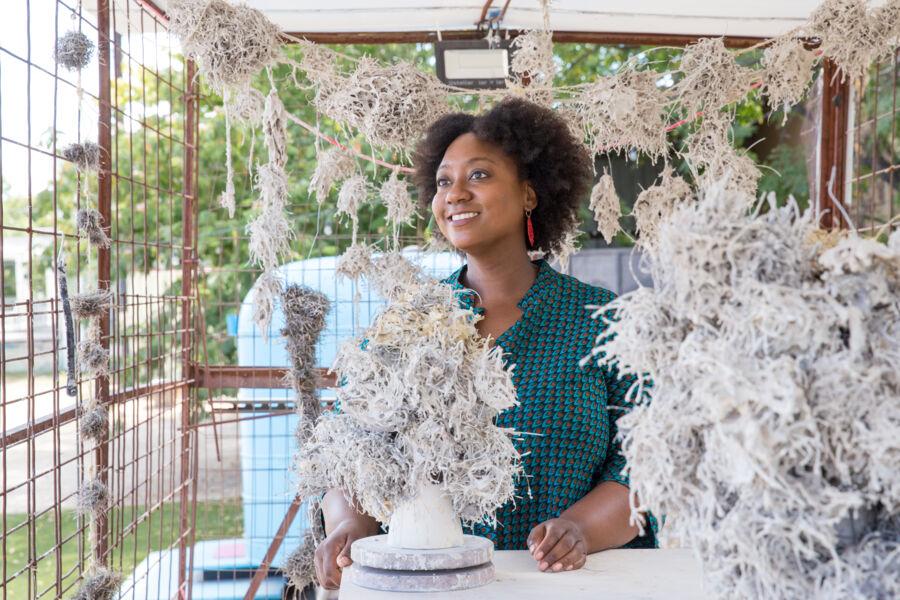Tammie Rubin: An Artist for Our Time
Contemporary artist and Assistant Professor of Sculpture and Ceramics Tammie Rubin disrupts the associations we have with mundane objects.
Her current body of work mines her family history and is an investigation of The Great Migration. From Chicago to Austin, she has found her footing in the community, exhibiting work in a host of group and solo-exhibitions, including a solo exhibit at Women and Their Work in Austin, which runs from Nov. 17 through Jan. 10. Here, Rubin shares insights about her background, art and teaching with St. Edward’s alumna Amarie Gipson ’18.

Challenging Our Perceptions of Artists’ Working Space: In Cage Match Project Round Vlll: This is Everything, Tammie Rubin set up her studio in a caged trailer, allowing her art making to be open and visible to the public.
Amarie Gipson: What is it like living and working in Austin as an artist?
Tammie Rubin: I enjoy Austin; it’s got its own quirkiness. The art community is small, but there’s lots of opportunity as well as a core group of artists who are working and interested in a variety of things. There’s something about the gritty, do-it-yourself nature that allows for more experimentation than more traditional, white-cube spaces like in New York.
AG: When did you decide to be an artist?
TR: When I went to college, I had no idea what I was going to do. As a first-generation student, it didn’t seem feasible to be an art major, but I eventually found my way into art classes. My professors were generous with their time and encouraged me to increase my abilities. I’m definitely an artist because of the environment I worked in as an undergrad.
AG: The first time I saw your work was in 2016 for your solo-exhibition, Before I Knew You, I Missed You. Could you talk about how your work mines your family history and is an investigation of the Great Migration?
TR: Growing up in Chicago, it was common for people to have family that lived down south. I was curious about modes of migration and wondered how African Americans made it to so many different places in the country. By the time I moved to Texas, both of my parents had passed away. I became more aware of how their history brought us to the present. It was such a fascinating and challenging experience, realizing there were all these things that I didn’t know about my family history.

AG: How do you make the ceramic cone forms, and what is your artistic process like?
TR: Accumulation is central to my work — adding information and pulling it away. I start with the idea that objects hold an innate power in themselves. Whether it’s something we see or something that is unrecognizable, we are drawn to objects and have our associations with them. To make the forms, I use a casting method and make a mold. The liquid clay that is poured into the plastic mold becomes a shell. The material is fragile, and I use that as a way to expand ideas of mapping and demography by drawing and collaging onto the surface.
AG: What is your experience working as an artist in this political climate?
TR: I feel like we live in a country where we have permanent amnesia. There’s a lack of accuracy and accountability that contributes to this complacency we see in politics. As an artist, I’m not living in isolation. When you share the work with the world, all this meaning is applied. My work became impactful in a way that maybe it would not have a year ago.
AG: How has your role as an educator shaped your artistic practice?
TR: I always wanted to be a teaching artist. I really believe in higher education because it is a place where you can really ask questions and explore a subject without judgment. Contemporary art is a living field, and I am tasked with finding the conversations as they unfold for myself and my students. Teaching and making fuel each other.
Photography by Whitney Devin ’10

Within the confines of her caged studio, Tammie Rubin dips ball moss into porcelain slip. The transformed plants are eventually attached to the ceramic conical forms that define much of Rubin’s work. The pieces will create part of her solo exhibition “Everything You Ever,” on display at Women and Their Work in Austin, Nov. 17 through Jan. 10, 2019.



